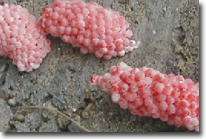
Reproduction
Little is known about specific or unique reproductive habits
of the species Fossaria parva, but much can be assumed based on
what is known of other species in the subclass Pulmonata.
Almost all freshwater pulmonates are considered hermaphroditic,
meaning that each individual organism contains both male and
female sex organs (Clifford,
1991). Fertilization is internal,
but usually not a product of self-fertilization.
Self-fertilization occurs when sperm that is produced
endogenously within the organism (or autosperm) fertilizes eggs
that were products of that same organism. Although this is
a convenient option, pulmonates prefer to have their eggs
fertilized by allosperm (sperm donated from another member of
the species). When one member of the species who has
mature sperm crosses paths with another, the 'male' (or donator)
mounts the shell of the 'female' (or receiver) and orients
himself in a way where insertion of a penis is possible.
Upon insertion into the receiver's vaginal canal, the sperm is
released and fertilizes the eggs (Dillon, 2000). Once
fertilized, the eggs pass through the female reproductive tract,
are covered in a gelatinous substance for protection then
expelled from the body. Most of the time, the egg sacs are
attached to a solid, aquatic substrate, like a rock or plant.
Once hatched, development is direct, meaning that the young
highly resemble their adult parents and there is not a
free-swimming larval stage (as there can be in other aquatic
gastropods) (Clifford,
1991).
This picture shows an example freshwater snail egg sac.

These two pictures (below) show two other
species of pulmonates, not Fossaria parva, engaging in
sexual reproduction.